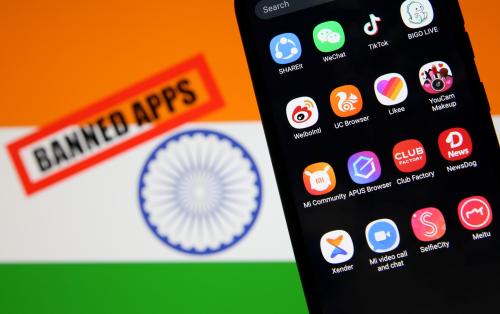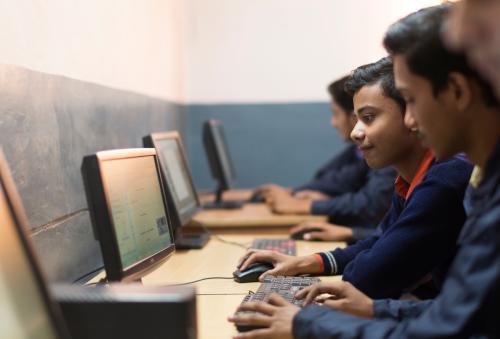Content from the Brookings Institution India Center is now archived. After seven years of an impactful partnership, as of September 11, 2020, Brookings India is now the Centre for Social and Economic Progress, an independent public policy institution based in India.
Heralded as the world’s largest school feeding programme, the Mid-Day Meal Programme in India reaches out to over 120 million children in over 1.26 million schools. State governments, along with funding from the national government, supply free lunches to children in primary and upper primary classes on working days in government schools. However, anecdotal evidence of inept service delivery suggest that the programme is fraught with leakages and corruption.
Leakages in government service delivery often come either in the form of corruption, or poor accounting practices which lead to inefficiencies in the way benefits reach the intended beneficiaries. Due the inherent information asymmetries prevalent in public provision, poor implementation of programmes could lead to erosion of public trust in government policies. Since revamping entire systems of public provision are very costly for governments, cheaper solutions such as the use of technology or the creation of incentives can help improve monitoring and supervision of government programmes.
Leakages in government service delivery often come either in the form of corruption, or poor accounting practices which lead to inefficiencies in the way benefits reach the intended beneficiaries.
Investigating the roll-out of a state-wide adoption of an Interactive Voice Response Systems (IVRS) on the functioning of the Mid-Day Meal Programme in Bihar, Sisir Debnath of the Indian School of Business presented his research for a Development Seminar at Brookings India in New Delhi. Given that a key challenge top-tier programme administrators face in the delivery of the mid-day meals is the reliance on the beneficiary estimates provided by mid-level delivery system administrators, the IVRS was implemented by the Bihar state government with the purpose of improving this very challenge through a full-automated platform that called one school teacher in every school every day to record the provision of a mid-day meal. This way data could be collated and re-verified on how many schools served the lunches and beneficiary take-up information would be accessible to the public through a web interface. The sample for the main analysis of roughly 6,000 observations was drawn from two sources: government accounts of Mid-Day Meal Programmes and a list of schools from the Annual Status of Education Report (ASER) database (which is collected by an Indian nongovernmental organisation, Pratham).
The aim of the Mid-Day Meals (MDM) Programme was to increase both attendance and micronutrients consumed by children. Debnath showed how accountability for several recipients of funding or benefits can be traced to a few managers. The managers at each node rely on quarterly reports of performance to renew funding. Debnath outlines the ineffectiveness of having several steps of bureaucracy in reaching targeted recipients. Instead he shows that the IVRS, which bypasses many of these steps, is far more effective in holding school administration accountable for the quality and delivery of mid-day meals.
The aim of the Mid-Day Meals (MDM) Programme was to increase both attendance and micronutrients consumed by children.
Debnath’s research verified that there are indeed greatly inflated reports of meal provision, and that an automated call to the headmasters or teachers at a school, randomly selected, actually helps cross-tabulate official reports. The Mid-Day Meal Programme started in 1995 and served the purposes of increasing attendance, improving child nutrition, besides preventing children dropping out of school and resorting to child labour. At the time, beneficiaries of mid-day meals received raw uncooked grains, that nonetheless aided them; but more recently, an additional step to provide cooked meals has been undertaken, incurring ‘conversion costs.’
Funding of the mid-day meal is contingent on the number of enrollees per school. Impressively, for this study, there were 70,000 headmasters, 99 per cent of whose mobile phones were registered and available for the IVRS calls. There were five allotted teachers per school in the sample and of the calls made during the study, roughly 80 per cent were completed.
Control states for this study included the neighbouring states of Jharkhand, Madhya Pradesh, Chattisgarh, and Odisha. Ninety per cent of the schools in these states claimed to provide meals in the control states, while the rate of provision in Bihar was around 60 per cent, far lower than the Annual Work Plan Budget (AWPB) reports of the government of nearly perfect compliance. Following the implementation of IVRS in 2012, the ASER data showed a leap in meal provision, with gradual decay in the years following. AWPB data, counterintuitively, showed a drop in provision around 2012 from perfect compliance.
Using the ASER data showed that mid-day meals were significantly more likely to be provided following 2012; and that meals were more likely to be cooked on the day of a surprise visit, likely owing to IVRS monitoring. However, when tests were conducted to compare ASER data with AWPB data, similarity in reporting in some areas but discrepancies in others were seen. Measures such as rice lifted from the warehouse were used as a proxy for resource allotment and estimates were built by looking at the effect in the post period minus the effect in the pre-period, added to the baseline measure.
A secondary result, using ASER data, was that while attendance increased following IVRS monitoring of mid-day meals, enrollment dropped. IVRS and the government’s quarterly progress reports (from the Mid-Day Meal Programme) when compared showed that while enrollment numbers aligned, beneficiaries’ numbers seemed inflated in the quarterly progress reports. The authors are now expanding their analysis to empirically test improvement in test scores and health outcomes in public schools that served meals as well as a heterogeneity analysis.
Debnath was able to independently assess that the IVRS helped reduce leakages, increased school attendance and improved the quality and quantity of meals per capita. While Debnath’s results have various policy implications, the impact that low-cost technological innovations and adjustments can have on other areas of government programmes that have similar delivery channels such as the public distribution system must be explored.
Technology-driven or enabled reform initiatives at the state level can succeed in improving delivery of important public services and the need to reform existing information channels and data gathering must be improved at every level, if not strengthened through technology.



Commentary
Using technology to improve the efficacy of school feeding programmes
August 2, 2018